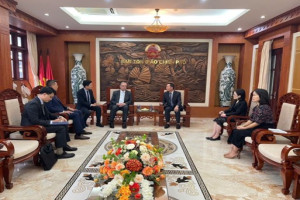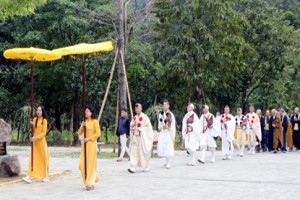
The custom of worshipping full-moon days aims to pray for peace and prosperity. On these days, Vietnamese people often offer teas, cakes, fruits and flowers to the Buddha and their ancestor.
The first full moon, known as Thuong Nguyen or Nguyen Tieu festival is observed on the 15th day of the first lunar month and one of important festivals of the year. On this day, people are supposed to go to pagodas and pray for good luck.
In localities with many residents of Chinese Vietnamese community, the festival features various other activities such as performances of traditional Chinese opera, lion dance, martial arts, calligraphy, lucky money, lantern offerings. In 2020, the Ministry of Culture, Sports and Tourism has recognized the First Full Moon Festival, or Tet Nguyen Tieu of Chinese community living in Ho Chi Minh City’s District 5 as a national intangible cultural heritage.
The 4th full moon festival or Vesak Day is the year’s most sacred day for Buddhists. It celebrates the birth, enlightenment and the passing away of Gautama Buddha. On 15th December 1999, at the 54th conference of the United Nations General Assembly, after discussing item agenda 174 of the program, the General Assembly has officially recognized the celebration or the Day of Vesak and considered it as the UN Day of religious cultural festival.
In Vietnam, the Vesak Day is always held solemnly with various activities such as parades, lantern releasing, art performances, etc. On this day, Buddhists usually go to pagodas for listening to Buddhist teachings and doing charity works.
The 7th full moon festival is called as “Vu Lan festival” (Parents' Day) or “Xa toi vong nhan” (Wandering Soul’s Day). The festival aims to show gratitude towards to parents and ancestors as well as educate the younger generations about their filial duties. According to folk beliefs, the festival is an occasion to pray for wandering souls.
The 8th full moon festival or Mid-Autumn festival is the day when the moon is at its brightest in a year. On this day, people usually prepare many different foods including moon cakes, candies and fruit, sit together to eat the food while appreciating the full moon. In big cities, celebrations often include lion and dragon dance parade. A legend associated with the Mid-Autumn festival is the story of Uncle Cuội with giant banyan tree.
According to Asian tradition, the 10th full moon festival honors the death anniversary of Dương Cốc God who helps people overcome calamities and tribulations. The festival is an occasion of thanksgiving, so everyone usually buys new sticky rice and specialties of autumn and winter to give to grandparents and the elders. The full moon in the tenth lunar month is also called the New Rice festival - an important tradition of the Vietnamese people.
PH (cantho.vn)



